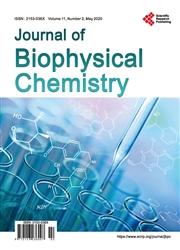Consequences of Non-Uniformity in the Stoichiometry of Component Fractions within One and Two Loops Models of α-Helical Peptides
引用次数: 2
Abstract
A 3-D electrostatic density map generated using the Wavefront Topology System and Finite Element Method clearly demonstrates the non-uniformity and periodicity present in even a single loop of an α-helix. The four dihedral angles (N-C*-C-N, C*-C-N-C*, and C-N-C*-C) fully define a helical shape independent of its length: the three dihedral angles, φ = -33.5°, ω = 177.3°, and Ψ = -69.4°, generate the precise (and identical) redundancy in a one loop (or longer) α-helical shape (pitch = 1.59 /residue; r = 2.25 ). Nevertheless the pattern of dihedral angles within an 11 and a 22-peptide backbone atom sequence cannot be distributed evenly because the stoichiometry in fraction of four atoms never divides evenly into 11 or 22 backbone atoms. Thus, three sequential sets of 11 backbone atoms in an α-helix will have a discretely different chemical formula and correspondingly different combinations of molecular forces depending upon the assigned starting atom in an 11-step sequence. We propose that the unit cell of one loop of an α-helix occurs in the peptide backbone sequence C-(N-C*-C)3-N which contains an odd number of C* plus even number of amide groups. A two-loop pattern (C*-C-N)7-C* contains an even number of C* atoms plus an odd number of amide groups. Dividing the two-loop pattern into two equal lengths, one fraction will have an extra half amide (N-H) and the other fraction will have an extra half amide C=O, i.e., the stoichiometry of each half will be different. Also, since the length of N-C*-C-N, C*-C-N-C*, and C-N-C*-C are unequal, the summation of the number of each in any fraction of n loops of an α-helix in sequence will always have unequal length, depending upon the starting atom (N, C*, or C).α-螺旋肽一环和二环模型中组分组分化学计量不均匀的后果
利用波前拓扑系统和有限元法生成的三维静电密度图清楚地表明,即使在α-螺旋的单个环中也存在非均匀性和周期性。四个二面角(N-C*-C- n, C*-C-N-C*和C-N-C*-C)完全定义了一个与长度无关的螺旋形状:三个二面角φ = -33.5°,ω = 177.3°和Ψ = -69.4°,在一个环(或更长)α-螺旋形状(节距= 1.59 /残差)中产生精确的(和相同的)冗余;R = 2.25)。然而,在肽11和肽22的主链原子序列中,二面角的模式不能均匀分布,因为4个原子的分数的化学计量不能均匀地分成11或22个主链原子。因此,α-螺旋结构中3组连续的11个主链原子将具有不同的化学式和相应的不同的分子力组合,这取决于在11步序列中指定的起始原子。我们认为α-螺旋的一个环的单位细胞位于肽骨架序列C-(N-C*-C)3-N中,该序列包含奇数个C*和偶数个酰胺基团。双环模式(C*-C-N)7-C*包含偶数个C*原子和奇数个酰胺基团。将双环模式分成两个长度相等的部分,一个部分将有额外的一半酰胺(N-H),另一个部分将有额外的一半酰胺(C=O),即每一半的化学计量量将不同。此外,由于n -C*-C- n、C*-C- n -C*和C- n -C*-C的长度不等,因此α-螺旋序列中n个环的任意部分中每个环的总长度总是不等的,这取决于起始原子(n、C*或C)。
本文章由计算机程序翻译,如有差异,请以英文原文为准。
求助全文
约1分钟内获得全文
求助全文

 求助内容:
求助内容: 应助结果提醒方式:
应助结果提醒方式:


